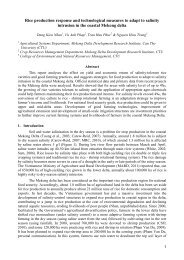start-with-the-park
You also want an ePaper? Increase the reach of your titles
YUMPU automatically turns print PDFs into web optimized ePapers that Google loves.
Delivering better green spaces<br />
87<br />
Partnerships and<br />
collaborations<br />
Young people were involved<br />
in <strong>the</strong> masterplanning process<br />
for Swanswell<br />
The Red Rose Forest’s Green<br />
Streets programme in deprived<br />
areas of Greater Manchester<br />
depends on members of <strong>the</strong><br />
community leading both <strong>the</strong><br />
consultation <strong>with</strong> neighbours<br />
and <strong>the</strong> design of <strong>the</strong> final<br />
improvements. On several<br />
streets, community groups have<br />
subsequently been formed to<br />
tackle o<strong>the</strong>r local problems<br />
Health and education authorities, utility<br />
companies, office <strong>park</strong>s and leisure<br />
organisations all hold significant stakes<br />
in vital areas of open land. It is important<br />
that all stakeholders in areas of both<br />
growth and low demand embrace <strong>the</strong><br />
principle of green infrastructure. They<br />
should develop effective means of<br />
working in partnership, drawing in a<br />
range of expertise from different sectors;<br />
provide funding from a range of sources;<br />
enable effective community involvement;<br />
and develop long-term and productive<br />
working relationships. A brief description<br />
of some of <strong>the</strong> organisations involved<br />
in <strong>the</strong> planning, design, delivery and<br />
maintenance of green places can be<br />
found in <strong>the</strong> appendix.<br />
Community involvement<br />
Successful design of green<br />
spaces combines creativity <strong>with</strong> an<br />
understanding of <strong>the</strong> local context.<br />
The people who live or work in <strong>the</strong><br />
area can best contribute much of that<br />
understanding. The new or improved<br />
space will play a part in <strong>the</strong>ir lives; it will<br />
serve <strong>the</strong>ir needs; and it will reflect <strong>the</strong>ir<br />
concerns and values. Involving local<br />
people depends on carefully planning<br />
an inclusive design process and on<br />
making sure both that participants have<br />
<strong>the</strong> necessary support to be able to<br />
contribute successfully and that all<br />
‘I’ve had a go at <strong>the</strong> design<br />
and we’ve got what we<br />
wanted – skate <strong>park</strong>, zip line<br />
and a whole load of o<strong>the</strong>r<br />
stuff. It feels good as at <strong>the</strong><br />
end of <strong>the</strong> year we’ll get a<br />
good name for Kendray ...<br />
I’ll be happy to bring up<br />
my kids here and hope<br />
<strong>the</strong>y have a good life here<br />
like I have.’<br />
Scott and Kieran, Kendray Play Project, Barnsley<br />
stakeholders are committed to <strong>the</strong><br />
process. CABE Space’s publication<br />
Green space strategies: a good practice<br />
guide 14 describes how a local authority<br />
can develop a public consultation plan.<br />
Real community involvement builds<br />
a sense of ownership that will lead<br />
to <strong>the</strong> space being cherished in <strong>the</strong><br />
years to come. Community ownership<br />
increases levels of self-policing and can<br />
reduce levels of vandalism and antisocial<br />
behaviour. It is important that <strong>the</strong><br />
involvement of local people – particularly<br />
young ones – continues beyond <strong>the</strong> initial<br />
design stage. Young people soon grow<br />
up, and each new generation of youth<br />
needs to be engaged.





